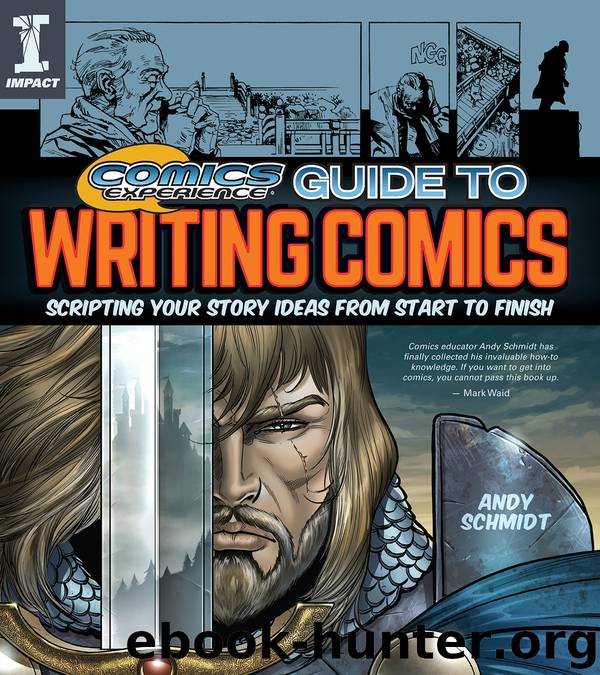Comics Experience Guide to Writing Comics by Andy Schmidt

Author:Andy Schmidt
Language: eng
Format: epub
Publisher: F+W Media
We’ve already discussed turning points, so you should be able to identify those, but a page turn is different. A page turn has to do with the reading experience more than the structure of your story. In comics, the reader has to turn the page. The reader can see multiple panels on a single page all at once. If the reader chooses, she can easily look into the past, present and future all at once—but only on a single page at a time.
What this means for you as the writer is that the page turn becomes one of your biggest tools. Yes, you need enough pages to incorporate your scene comfortably, but the more you can compel your reader to want—to need—to turn that page, the better.
There are a number of ways you can use the page turn to your advantage, but almost all of them boil down to this: Your last panel should compel your reader to turn that page. That means the panel causes your reader to ask a question that he wants an answer to or builds up anticipation for what comes next in your story. I think of them as kind of a “push” or a “pull” technique. Asking a question pulls your reader to the next page, while building anticipation pushes your reader. Either will work, but I try to do one on every page.
A word of clarification. I say “the last panel,” but you really could do this over the course of the entire page or even over a multipage sequence for a particularly large buildup of anticipation. Remember that each act is about rising tension. So each scene is structured similarly, and each page should also be structured similarly. Release and build up until the reader has to turn that page to get the answer he seeks.
Let’s go back to that example with the female detective going into the dark house from Chapter 3. I’ve changed the wording slightly to make it read like a scene so we can break it down into pages.
Our female detective enters a spooky house and is attacked. But during the struggle with her attacker, she wounds the assailant and shoves him into a dresser that shatters on impact, knocking the assailant out—one down, but there could be others. She looks down and the clue she needs has fallen out of the shattered dresser—she grabs the clue! She got what she needs and hurries out of the house with no further incident.
This is our scene. Now let’s break it down into pages with some explanation of the breaks:
Download
This site does not store any files on its server. We only index and link to content provided by other sites. Please contact the content providers to delete copyright contents if any and email us, we'll remove relevant links or contents immediately.
Make Comics Like the Pros by Greg Pak(2852)
Draw-A-Saurus by James Silvani(2655)
Modern Cartooning by Christopher Hart(2557)
Manga Workshop Characters by Sophie Chan(1912)
Manga Crash Course Fantasy by Mina Petrovic(1893)
Creative Character Design by Bryan Tillman(1888)
The Absolutely True Diary of a Part-Time Indian by Sherman Alexie(1856)
How To Draw Caricatures by Lenn Redman(1613)
Freehand Figure Drawing for Illustrators by David H. Ross(1586)
How to Draw a Character by Soizic Mouton(1585)
Learn to Draw Action Heroes by Robert Marzullo(1554)
The DC Comics Guide to Coloring and Lettering Comics by Mark Chiarello(1544)
How to Draw an Object by Soizic Mouton(1543)
Supergods by Grant Morrison(1537)
Stan Lee's How to Draw Comics by Stan Lee(1531)
The DC Comics Guide to Writing Comics by Dennis O'Neil(1508)
ANIME Drawing BOX set 5-in-1: Anime Drawing for Beginners, Drawing Anime Faces, Drawing Anime Emotions, Manga Drawing for Beginners, Anime Drawing Practical Guide by Li Shen & Jane Mackle & Yuka Hiramatsu(1430)
Secret Teachings of a Comic Book Master by Heidi MacDonald(1371)
American Political Cartoons by Stephen Hess & Sandy Northrop(1310)
